6 Focused Assessment – Mental Health and Status
Learning Objectives
At the end of this chapter, the learner will:
- obtain mental health history.
- perform mental status examination
- utilize therapeutic communication techniques to obtain a mental health history and mental health examination.
- document the mental status examination.
I. Overview of Mental Health and Mental Status:
Mental Health is described as the ability to adjust to changes and the stressors of life by using positive coping mechanisms. Mental Health incorporates emotions, thoughts, feelings, the ability to problems solve and overcome difficulties, maintain social bonds and understand the world around us and make healthy choices. Therefore, mental health includes our emotional, psychological, and social well-being.
Mental Illness is defined as a disorder that prevents a person from coping with everyday life and requires long-term treatment. The disorder/illness affects how the person thinks, feels, behaves, and interacts with others. These changes in thinking, feeling, and behaving, any one or all three, can cause the individual emotional distress and alter the manner in which the individual functions. Mental illness, especially depression, increases the risk for many types of physical illness especially chronic illness, e.g., Diabetes Mellitus II and Coronary Heart Disease. The reverse is also true that chronic illnesses can potentiate mental illnesses. It is possible to have imperfect mental health without a mental illness and it is also possible to have good mental health while having a diagnosis of a mental illness/psychiatric condition.
It is also possible to have different types of mental illnesses or disorders at the same time or at different types. Mental illness can be short-term, episodic, or long-term.
According to the Center for Disease Control and Prevention mental illnesses are “among the most common illness in the United States.”(Center for Disease Control and Prevention 2018)
The statistics:
- 50% of individuals will have a mental status illness/disorder in their life.
- Every year 1 in 5 people will demonstrate signs of mental illness.
- At some point in their lives, 1 in 5 children will experience “debilitating mental illness.”(Merikangas & Burstein 2010)
- Severe mental illness including schizophrenia, bipolar disorder, or major depression is suffered by 1 in 25 Americans.
Factors that can contribute to Mental Illness include:
- Early life trauma.
- Chronic diseases.
- Individual biological data e.g. genetic makeup.
- Social isolation.
- Lack of social support.
- Use of illicit drugs and alcohol.
- Earlier onset of puberty.
- there may be a mismatch between the child’s appearance and the way she acts and thinks.
- For girls is associated with depression, substance use, eating disorders, disruptive behavior disorders, and early sexual behavior (Graber, 2013).
- Early maturing girls demonstrate more anxiety and less confidence in their relationships with family and friends, and they compare themselves more negatively to their peers (Weir, 2016).
- For girls, the emphasis on physical attractiveness and sexuality is emphasized at puberty and they may lack effective coping strategies to deal with the attention they may receive. https://courses.lumenlearning.com/suny-lifespandevelopment/chapter/sexual-development/
Mental Status is defined as a comprehensive assessment of an individual’s intellectual capacity, emotional state, and mental health. Mental status is assessed by the observations of the health care provider and the direct one-to-one interviews. A mental status assessment observes mood, behavior, orientation, judgment, memory, problem-solving ability, functioning society, and contact with reality.
II. Anatomy and Physiology
The Brain is made up of billions of nerve cells that communicate with even more connections called synapses. At the synapses, there are chemical and electrical reactions that maintain brain health. This process is called synaptic stability and any disruption in how the neurons communicate may lead to many psychiatric and neurological diseases.
Synapse Pathology in Psychiatric and Neurologic Disease: https://www.ncbi.nlm.nih.gov/pmc/articles/PMC2857788/
The Neuron:
The Neuron
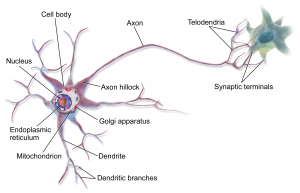
Communication between the nerves:
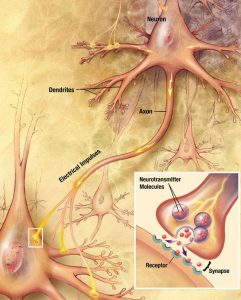
Clinical manifestations may be explained by dysfunction in anatomy and physiology. Therefore, understanding these concepts is essential.
The specialized areas of the brain include:
- The cortex is the outermost layer of the brain that is responsible for voluntary movements.
- The brain stem lies between the brain and the spinal cord and is responsible for breathing and sleep.
- The basal ganglia is inside the middle of the brain and is responsible for coordinating the “messages” between many different parts of the brain.
- The cerebellum is at the base of the brain and is responsible for coordinating and balance.
The lobes of the brain include:
- “The frontal lobe is responsible for problem-solving and judgment and motor function.”(2021 WebMD)
- The parietal lobe is responsible for sensation, handwriting, and body position.
- The temporal lobe is responsible for memory and hearing.
- The occipital lobe is responsible for vision.
The brain is protected by the meninges and the skull.
The Inside of the brain: if the picture is not visible then click this link: https://www.creativemoment.im/bh-demos-memo/
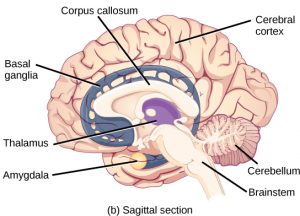
The parts of the brain-If the picture is not visible please click this link: https://opentextbc.ca/biology/chapter/16-3-the-central-nervous-system/
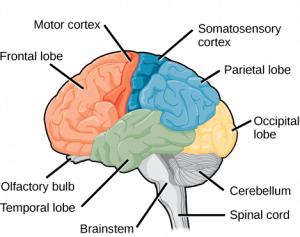
Knowledge Check
III. Medical Terminology
| Abstract reasoning | Abstract thinking is the ability to understand concepts that are real but are not directly associated with concrete physical objects and experiences. |
| Affect | Affect is the patient’s immediate expression of emotion which can range from elation to suffering. |
| Anxiety | An emotion characterized by feelings of tension, worried thoughts, and physical changes like increased blood pressure. |
| Behavior | The way in which one acts or conducts oneself, especially toward others or |
| Bipolar disorder | Bipolar disorder (formerly called manic-depressive illness or manic depression) is a mental disorder that causes unusual shifts in mood, energy, activity levels, concentration, and the ability to carry out day-to-day tasks. |
| Calculation ability | The ability to add, subtract, divide, and multiply numbers quickly and accurately. |
| Communication skills | Evaluates the patient’s speech for clarity, fluency, rate, rhythm, volume, tone, and the ability to read and understand others. |
| Cognitive function | Utilize several cognitive domains, such as memory, language, perception, attention, and executive functions (Lezak et al., 2004). |
| Delirium | A serious disturbance in mental abilities that results in confused thinking and reduced awareness of the environment |
| Dementia | The loss of cognitive functioning—thinking, remembering, and reasoning—and the ability to function and behave appropriately. |
| Depression | Mental illness negatively affects emotions, feelings, thinking, and behavior. |
| General appearance | Includes physical appearance, grooming, posture, eye contact, and overall first impression. |
| Insight | The ability to understand the true nature of one’s situation and accept personal responsibility for that situation (Videbeck, 2021). |
| Impulse control | The ability to delay gratification in an effort to display socially appropriate behaviors (Videbeck, 2021). |
| Intelligence | The ability to think, to learn from experience, to solve problems, and to adapt to new situations |
| Judgment | The capacity to recognize relationships, draw conclusions from evidence, and make critical evaluations of events and people. |
| Memory | The ability to recall a name or event. There are three sub-categories: short-term memory, and long-term storage. |
| Orientation | Orientation largely reflects memory function. |
| Reality testing | “Ability to distinguish between self and non-self and between fantasy and real life. Defective reality testing is the major feature of psychosis.” |
| Reasoning | The ability to think through facts and theories to come up with a conclusion. |
| Schizophrenia | A chronic mental disease with symptoms of delusions, hallucinations, disorganized speech, inability to think, and lack of motivation is noted. |
| Thought process and content | The cognitive processes involved in such mental activities as reasoning, remembering, imagining, problem-solving, and making judgments |
Two conditions that increase the risk for mental illness include Addiction and Abuse. Knowing how to assess a patient with addiction or correlating assessment findings with abuse can be life-saving.
The following articles will explain the above statement in detail.
-
- Rayan, A., Assessment, and Management of Patients With Drug Abuse: Nurses Should be Involved. Journal of Addiction and Dependence 2017 pg. 01-04 https://doi.org/10.15436/2471-061X-17-037
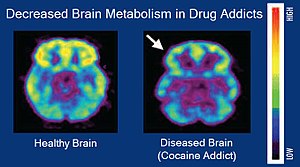
-
- MR, King KC, Jordan GA, et al. Domestic Violence. [Updated 2021 Apr 19]. In: StatPearls [Internet]. Treasure Island (FL): StatPearls Publishing; 2021 Jan-. Available from: https://www.ncbi.nlm.nih.gov/books/NBK499891/

- MR, King KC, Jordan GA, et al. Domestic Violence. [Updated 2021 Apr 19]. In: StatPearls [Internet]. Treasure Island (FL): StatPearls Publishing; 2021 Jan-. Available from: https://www.ncbi.nlm.nih.gov/books/NBK499891/
The nurse has an important role in identifying risk factors for suicide. More detail will be in the link below: Put in orange box
Please read this article and think about how the nurse would intervene by assessing behavior:
Farley, Holly R. EdD, RN Assessing mental health in vulnerable adolescents, Nursing: October 2020 – Volume 50 – Issue 10 – p 48-53 doi: 10.1097/01.NURSE.0000697168.39814.93 Available from: https://journals.lww.com/nursing/Fulltext/2020/10000/Assessing_mental_health_in_vulnerable_adolescents.12.aspx
A suicide prevention tool:
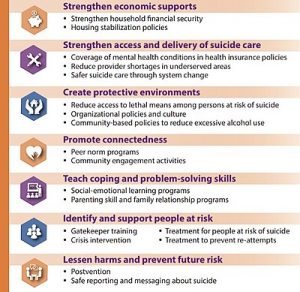
Knowledge Check
IV. Step by Step Assessment:
- Perform hand hygiene.
- Check room for contact precautions.
- Introduce yourself to the patient.
- Confirm patient ID using two patient identifiers (e.g., name and date of birth).
- Explain the process to the patient.
- Assemble equipment prior to starting the exam.
- Be organized and systematic in your assessment.
- Use appropriate listening and questioning skills.
- Listen and attend to patient cues.
- Ensure patient’s privacy and dignity.
- Apply principles of asepsis and safety.
- Check vital signs.
Assessment of mental status may not occur routinely. In the hospital setting the nurse completes a full mental status assessment on admission and any time during the individual’s hospital stay to establish if a change in mental state has occurred. Portions of mental health assessment will be routinely assessed by nurses in almost all healthcare settings because the patient’s mental health state is an integral aspect of the patient’s overall health status.
| Steps |
Additional Information |
| 1. Introduction | Introduce yourself to the patient and explain why and how the mental status exam will be completed. Ensure that the environment is clean, quiet, and non-threatening. |
| 2. Patient Observation | Inspect the patient for the following:
General appearance Utilize what is seen and heard to direct the conversation to gather as much data as possible |
| 3. Document assessed data | Include primary language, demographics, education, mental, physical, and social functionality, support system, current problem, Past medical, physical, and psychiatric histories, past life trauma, mood, emotions, nutrition, sleep, sexuality, thinking, Perceptions (Hallucinations), orientation, cognition and memory and finally all data obtained through observing all topics listed above.
The Mini-Mental State Examination: This tool is widely used to assess cognitive impairment in several settings including inpatient, research, and community settings |
The video below describes each section of the mental status exam.
The standard format for documenting the Mental Status Examination varies a little, but as long as all areas are covered the exact order is not crucial.
Format for documenting the Mental State Examination:
- Appearance and Behavior
- Speech
- Mood
- Subjective
- Objective
- Risk
- Thoughts
- Form
- Content
- Beliefs – Overvalued or Delusional
- Perceptions
- Cognition
- Insight
A sample of narrative documentation
This sample note was obtained from:
Gary Sparrow, a 48-year-old white male, was disheveled and unkempt on presentation to the hospital emergency room. He was wearing dirty khaki pants, an unbuttoned golf shirt, and white shoes and appeared slightly younger than his stated age. During the interview, he was agitated and restless, frequently changing seats. He was impatient and sometimes rude in his interactions with this examiner. Mr. Sparrow reported that today was the best day of his life because he had decided to join the professional golf circuit. His affect was labile, but appropriate to the content of his speech (i.e., he became tearful when reporting he had “bogeyed number 15”). His speech was loud, pressured, and overelaborative. He exhibited loosening of associations and flight of ideas; he intermittently and unpredictably shifted the topic of conversation from golf, to the mating habits of geese, to the likelihood of extraterrestrial life. Mr. Sparrow described grandiose delusions regarding his sexual and athletic performance. He reported auditory hallucinations (God had told him to quit his job and become a professional golfer) and was preoccupied with his athletic and sexual accomplishments. He was oriented to time and place but claimed he was the illegitimate son of Jack Nicklaus. He denied suicidal and homicidal ideation. He refused to participate in intellectual- or memory-related portions of the examination. Mr. Sparrow was unreliable and exhibited poor judgment. Insight was absent.
Sekhon N, Moukaddam N, Tucci V. Like a Modern Day, Sherlock Holmes: Diagnosing and Differentiating the Etiology of Altered Mental Status. Madridge J Intern Emerg Med. 2017; 1(1): 14-24. doi: 10.18689/mjiem-1000104
VI. Related Laboratory and Diagnostic Procedures/ Findings:
Some conditions may affect the mental status of a patient, such as low oxygen levels, infections. or substance abuse. Thus, tests will be used to detect hypoxia, viral/bacterial meningitis and other infections, drug presences, and alcohol levels that may be causing a change in mental status.
Depending on other assessment data, commonly ordered tests for patients coming into the Emergency room with mental status changes are listed:
- Complete blood count (CBC) to assess White blood cells, Hemoglobin, Hematocrit, and platelet count to check for anemia, infection, and abnormal blood cell count diseases including leukemia.
- Complete Chemistry Profile CMP) to assess electrolytes, kidney and liver function, and glucose.
- Erythrocyte sedimentation rate (ESR) to assess for inflammation caused by infections, autoimmune disease, and possible tumors.
- Urinalysis is completed to check for urinary infection, kidney disease, diabetes, dehydration, and urine concentration.
- B12 and folate are ordered to assess for anemia and possible alcoholism.
- electroencephalogram (EEG) is ordered for patients with new-onset psychosis to assess for epilepsy and brain disease.
- electrocardiogram (EKG) is ordered to screen for cardiac disease.
- chest x-ray film to access for heart and lung disease.
A more detailed overview about mental health and the different types of Mental Illness please click on this link: The importance of Mental Health
VII. Learning Exercises
VIII. Citation and Attribution
Learning about Mental Health, CDC Reviewed January 26, 2018, Retrieved July 29, 2021 https://www.cdc.gov/mentalhealth/learn/index.htm
AAP https://www.aap.org/en-us/advocacy-and-policy/aap-health-initiatives/Mental-Health/Documents/MH_ScreeningChart.pdf
Working with People who are Mentally Ill https://milnepublishing.geneseo.edu/home-health-aide/chapter/working-with-people-who-are-mentally-ill/
The difference between mental health and illness https://insidemypurse.co.za/2019/10/31/the-difference-between-mental-health-and-illness/?gclid=CjwKCAjw87SHBhBiEiwAukSeUbg3uUiupghg0cWddctRZDvIlui8L5w5OcP5xh8KAE8Z530doBVDBBoChAAQAvD_BwE
Emotional Health and Mental/Emotional Disorders https://courses.lumenlearning.com/diseaseprevention/chapter/emotional-health-and-mentalemotional-disorders/
Mental Status https://medical-dictionary.thefreedictionary.com/mental+status
Mental Status exam https://www.youtube.com/watch?v=RdmG739KFF8
How to Conduct a Mental Status Exam https://www.youtube.com/watch?v=2fOvfV3RDXc
How to do the Mental Status Exam | Merck Manual Professional Version https://www.youtube.com/watch?v=14s9jMf4vR8
Mental Health https://www.cdc.gov/mentalhealth/learn/index.htm
THE BRAIN & MENTAL HEALTH https://www.youtube.com/watch?v=pov3X-teO24
The Mental Status Examination https://www.ncbi.nlm.nih.gov/books/NBK320/
The Mental Status Exam by Wikipedia https://en.wikipedia.org/wiki/Mental_status_examination
Complete blood count (CBC) Mayo clinic by Mayo Clinical staff. Retrieved 13:00 July 28, 2021, https://www.mayoclinic.org/tests-procedures/complete-blood-count/about/pac-20384919
Anfinson TJ, Kathol RG. Screening laboratory evaluation in psychiatric patients: a review. Gen Hosp Psychiatry. 1992 Jul;14(4):248-57. doi: 10.1016/0163-8343(92)90095-r. PMID: 1505746.
Erythrocyte Sedimentation Rate (ESR) lab test online Retrieved 13:33 July 28, 2021, https://labtestsonline.org/tests/erythrocyte-sedimentation-rate-esr
Urinalysis Mayo clinical Retrieved 13:06 July 28, 2021 https://www.mayoclinic.org/tests-procedures/urinalysis/about/pac-20384907#:~:text=A%20urinalysis%20is%20used%20to,to%20a%20disease%20or%20illness.
Sands, T., Bjork,M.,H., Vaaler, A., E. Is EEG a useful test in adult psychiatry? Tidsskriftet 2012 October 23; (11) 1200doi: 10.4045/tidsskr.12.1253
Enoch MA, Goldman D. Problem drinking and alcoholism: diagnosis and treatment. Am Fam Physician. 2002 Feb 1;65(3):441-8. PMID: 11858627.
Rayan, A., Assessment and Management of Patients With Drug Abuse: Nurses Should be Involved. Journal of Addiction and Dependence 2017 pg. 01-04 https://doi.org/10.15436/2471-061X-17-037 Retrieved July 28, 2021. https://www.ommegaonline.org/article-details/Assessment-and-Management-of-Patients-With-Drug-Abuse-Nurses-Should-be-Involved/1271
MR, King KC, Jordan GA, et al. Domestic Violence. [Updated 2021 Apr 19]. In: StatPearls [Internet]. Treasure Island (FL): StatPearls Publishing; 2021 Jan-. Available from: https://www.ncbi.nlm.nih.gov/books/NBK499891/
Decreased Brain Metabolism in Drug Addicts PET scan images showing brain metabolism in those with addictions vs controls. Addiction disrupts the normal, healthy functioning of the brain. Created February 14, 2018 Public domain Retrieved July 28, 2021, https://en.wikipedia.org/wiki/Addiction#/media/File:Brain_metabolism_and_drug_addiction.jpg
Creative Commons brain image by OpenStax College: The Central Nervous System. OpenStax CNX. May 10, 2013 http://cnx.org/contents/24e8609c-16a7-4dd5-b3da-e38aaeef7ed5@4@4.
Concepts of Biolog-1st Canadian Edition 16.3 The Central Nervous System, Figure of The human cerebral cortex includes the frontal, parietal, temporal, and occipital lobes. https://opentextbc.ca/biology/chapter/16-3-the-central-nervous-system/
Picture of the Brain, Human Anatomy by Matthew Hoffman, MD June 23, 2021, https://www.webmd.com/brain/picture-of-the-brain
The Neuron, Wikipedia The Free Encyclopedia, last edited 04:34 July 25, 2021, Retrieved 03:03 July 29, 2021, https://en.wikipedia.org/wiki/Neuron
van Spronsen, M., and Hoogenraad, C.,C. Synapse Pathology in Psychiatric and Neurologic Disease. Curr Neurol Neurosci Rep. 2010; 10(3): 207–214, Retrieved 03:29 July 29, 2021 https://www.ncbi.nlm.nih.gov/pmc/articles/PMC2857788/
Suicide prevention Wikipedia The Free Encyclopedia edited at 03:08 July 9, 2021 Retrieved July 29, 2021. https://en.wikipedia.org/wiki/Suicide_prevention
Lally M., and Valentine-French, S. Lifespan Development. Sexual Development https://courses.lumenlearning.com/suny-lifespandevelopment/chapter/sexual-development/
Medical Terminology resources:
https://www.healthline.com/health/abstract-thinking; https://www.healthline.com/health/flat-affecthttps://dictionary.apa.org/affect; https://www.apa.org/topics/anxiety; https://en.wikipedia.org/wiki/Behavior; https://www.nimh.nih.gov/health/topics/bipolar-disorder/; https://www.ncbi.nlm.nih.gov/books/NBK546682/; https://www.sciencedirect.com/topics/psychology/cognitive-functioning; https://www.mayoclinic.org/diseases-conditions/delirium/symptoms-causes/syc-20371386; https://www.nia.nih.gov/health/what-dementia-symptoms-types-and-diagnosis#:~:text=Dementia%20is%20the%20loss%20of,person’s%20daily%20life%20and%20activities; https://dictionary.apa.org/insight; https://americanaddictioncenters.org/co-occurring-disorders/impulse-control-disorder; https://opentextbc.ca/introductiontopsychology/chapter/9-1-defining-and-measuring-intelligence/; https://dictionary.apa.org/judgment; https://www.ncbi.nlm.nih.gov/books/NBK320/; https://dictionary.apa.org/reality-testing; https://dictionary.apa.org/reasoning; https://www.psychiatry.org/patients-families/schizophrenia/what-is-schizophrenia#:~:text=Schizophrenia%20is%20a%20chronic%20brain,thinking%20and%20lack%20of%20motivation; https://dictionary.apa.org/thought-process
Videbeck, S. L. (2021). Psychiatric-Mental Health Nursing (8th ed.). Wolters Kluwer.

